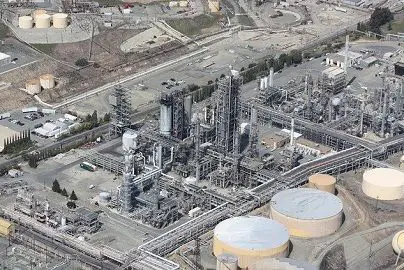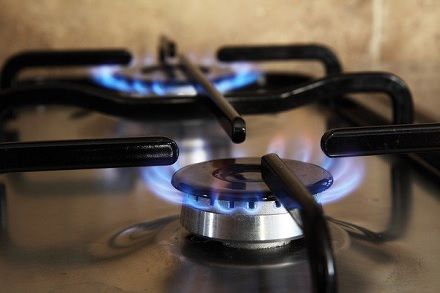Liquefied Petroleum Gas or LPG is the very known name for all of you, as it is known as the cooking gas. It is one of the natural gas which can be obtained as a by-product from the processing of natural gas and petroleum refining. It consists of butane, propane and butylene. Compressed Natural Gas or CNG is widely used gas in cars, and it is also a natural gas which is obtained from methane wells, coal bed. It consists of methane.
These natural gases distribution is easy for the long-distance through the pipelines, and are cheaper than diesel and gasoline. LPG and CNG have a wide range of applications, like in industries, automobiles, as a cooking fuel, refrigerant, etc. However, these gases release greenhouse gas (CO2 and CO) but in less amount than the gasoline.
Deep beneath the surface, natural gas is found, these are called reservoirs. Millions of years ago, when the marine plants and animals died and sunk into the bottom of the sea, they got buried under sedimentary rocks by the natural process. Gradually, with the time, intense pressure and heat, these dead matters got transformed and converted into a gas, and that is natural gas.
Natural gas has many different compounds, and methane (CH4) is found in larger quantity, apart from this, it (natural gas) also contains hydrocarbons gas liquids, natural gas liquids and other non-hydrocarbon gases. With this, we will be learning about the general differences between the LPG and CNG, along with a brief description of them followed by the key differences on the same.
Content: Liquefied Petroleum Gas (LPG) Vs Compressed Natural Gas (CNG)
Comparison Chart
| Basis for Comparison | Liquefied Petroleum Gas (LPG) | Compressed Natural Gas (CNG) |
|---|---|---|
| Meaning | Liquified Petroleum Gas is the kind of natural gas, which is highly flammable and is obtained from the reservoir of a gas field. | Compressed Natural Gas is also the kind of natural gas, but it has less ignition as compare to LPG, it is obtained from coal well, oil wells, etc. |
| It is obtained from | LPG is a product which is extracted from the reservoir of the gas field. It is the by-product of one of the process while refining crude-oil. | CNG is a natural gas which is obtained from coal bed, methane wells, oil wells and from natural gas wells. |
| Properties | LPG being heavier than air gets quickly accumulate on low-lying areas, this gas is highly flammable. | Being lighter than air, CNG does not get easily accumulate on and disperse quickly. |
| Constituents | LPG contains Propane and Butane. | CNG contains methane. |
| Calorific values | LPG has a calorific value of 90 to 95 MJ/m3. | CNG has low calorific value as 35 to 40 MJ/m3. |
| Impacts on the environment | LPG releases CO2 (one of the greenhouse gas). | CNG also release greenhouse gas but in less amount. |
| Risk of using | LPG is highly flammable, and it does not get easily disperse, so one should be careful while using. | CNG has less risk of ignition as it is dispersible. |
| Uses | LPG is commonly known as cooking gas, so widely used in homes and restaurants for cooking purposes. | It is used industrially, as a refrigerant, and also as automobile fuel. |
Definition of Liquefied Petroleum Gas (LPG)
LPG is also known as autogas. Propane or butane is another name for the Liquified Petroleum Gas or LPG. This gas is highly flammable and is heavier than air; it gets settles at the bottom of the surface.
LPG is composed of the various hydrocarbons gases. It is widely available around the world and is considered as the most efficient, readily available fuel with economical prices.
LPG is primarily used as fuel for heating cooking appliances, fuel for automobiles, and in some other industries also. These are produced as the by-product of the petroleum refining and natural gas processing. It is filled in the pressurized cylinders and sent for transportation or storage.
A foul smell, which we can sense is of the mercaptans, a substance introduced in such gas cylinders so that it can be easily recognized in case of any leakage.
Definition of Compressed Natural Gas (CNG)
Compressed Natural Gas (CNG) also known as “clean fuel“, is the compressed methane gas (CH4) at the pressure of 200 to 248 bars. CNG is cheaper than LPG. It is a non-pollutant, which creates a clean fuel and cause no harm to the atmosphere.
CNG is obtained from coal bed, methane wells, oil wells and from natural gas wells. This gas is produced by compressing natural gas made up of CH4 and methane. Likewise, the LPG, it is also stored in hard containers like cylinders at the pressure of 20-25 MPa.
As compared to the petrol and diesel, CNG is available at a lower price, so this is considered a good sign for the four-wheeler owner to switch to this pollutant-free or clean fuel from diesel or petrol. CNG releases very less amount of greenhouse gases than the LPG, that produces carbon dioxide; although both are cleaner than compared to gasoline.
Key Differences Between Liquefied Petroleum Gas (LPG) and Compressed Natural Gas (CNG)
Given below are the points that show the general differences between the two types of natural gases:
- Liquified Petroleum Gas (LPG) and Compressed Natural Gas (CNG) are the kinds of natural gases; LPG is highly flammable and is obtained from the reservoir of a gas field, whereas CNG but it has less ignition as compared to LPG, and is obtained from coal well, oil wells, etc.
- LPG is extracted from a reservoir of the gas field. It is the by-product of one of the process while refining crude-oil; on the other hand, CNG is a natural gas which is obtained from coal bed, methane wells, oil wells and from natural gas wells.
- LPG being heavier than air gets easily accumulate on low-lying areas, and is highly-flammable; However, CNG is lighter than air and does not get easily gather and disperse quickly.
- LPG contains Propane and Butane and has a calorific value of 90 to 95 MJ/m3; whereas CNG contains methane and has low calorific value as 35 to 40 MJ/m3.
- LPG releases CO2 (one of the greenhouse gas), while CNG also releases a greenhouse gas, but in less amount.
- While using, one should be very careful as LPG is highly flammable and it does not get easily disperse; on the other hand, CNG has less risk of ignition as it is dispersible.
- LPG is commonly known as cooking gas, and it is widely used in homes and restaurants for cooking purposes. In contrast, CNG is used industrially, as a refrigerant, and also as automobile fuel.
Similarities
- LPG and CNG are the natural gases that are domestically as well as industrially used. These are also used as automobile fuel.
- These gases are used as transposable fuels because they are stored in cylinders.
- As compared to diesel and petrol, they have reduced the emission of greenhouse gas.
Conclusion
Earlier, LPG was considered as the clean fuel, but nowadays CNG is regarded as the clean fuel and has replaced diesel and petrol automobiles. But due to the volatility nature, narrow range of flammability and high auto-ignition temperature (540o C) CNG is not used as the cooking gas. So, LPG is still used and has maintained its importance in becoming useful and essential while cooking.
But, after such advantages and usefulness, these gases have the biggest disadvantage, and that is they catch fire, and LPG catches too quickly as compared to CNG. So, one should be careful while using these gases.



GasNtools says
The comparision chart that yu shared here was very useful and informative. You compared various properties of LPG and CNG. Thanks for sharing it.
hstbd says
Thanks for this valuable chart of LPG and CNG. Very informative.
teter jjkjk says
Very Informative Chart. Thanks for this LPG and CNG Chart. Thanks